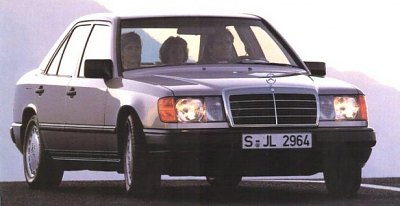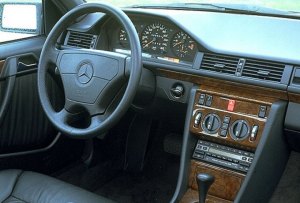|
A
quarter of a century has passed since the birth of W124-series Mercedes
E-class, yet every time we see it on the road it looks incredibly fresh
to eyes. For sure, the timeless design by Bruno Sacco plays a major
role in its evergreen status, but more important, the W124 was probably
the best engineered car ever made. It was developed when Mercedes was
still putting engineering – instead of financial – targets in first
priority. Lengthy development and extensive testing process made it
nearly flawless. It was so durable and reliable that most production
cars still exist today. Provided proper maintenance, they can easily
look like new cars !
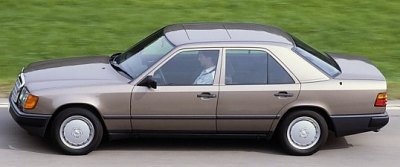
The underpinning of
the mid-size Mercedes was very similar to that of the smaller 190. It
shared the latter's struts front and sub-frame-mounted multi-link rear suspensions so to deliver fine
handling and ride. Stuttgart's traditional recirculating-ball steering
might be a little slow and vague, but it contributed to an effortless
driving together with 4-speed automatic gearbox. 300E provided a 188hp
single-cam 3-liter straight-six, which was creamy smooth and eager to
rev. Hydraulic engine mounts enhanced running refinement further.
Thanks to the low drag, performance was good, i.e. 140 mph flat out on
Autobahn and sub-8 seconds 0-60 mph. The latter was every bit
believable as Autocar magazine timed 8.4 sec on a damp track. American
version was a little slower due to detuned engine and catalytic
converter. If you want refinement, avoid the 4-cylinder 230E.
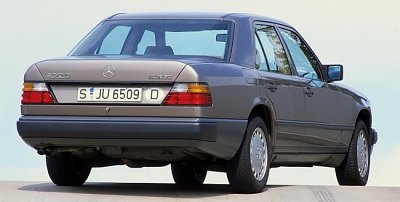
Since BMW 5-series E34 arrived in 1988, the E-class was no
longer the favourite of the motoring writers. However, it continued to
win in
sales race as well as the test of time. Today, the owners of W124 must
be proud that they made the right choice, for their cars not only
outlasted the competition but are also set to attain classic status.
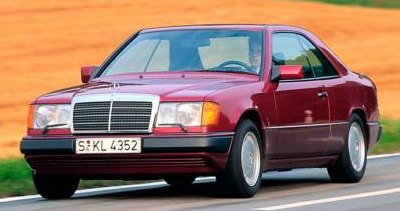
Due to the necessary chassis reinforcement compensating the loss of
B-pillars, the coupe was slightly heavier than the saloon.
However, road tests found its performance was no worse, and perfectly
adequate for its duty. Later 300CE-24 should give better performance
from its 231hp 24-valve engine. Nevertheless, the CE was more about
high-speed refinement than back-road handling. Its steering was a
little slow and suspension a little stiff for that usage. Its strength
was again comfort, build quality and style. Demanding drivers had
better to turn to BMW 635CSi.
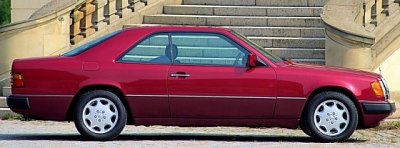
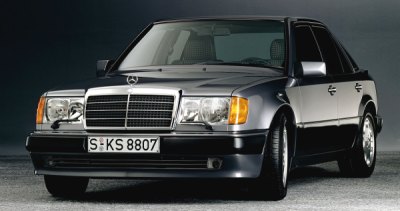
500E
was a joint project between Mercedes and Porsche. Envying the success
of BMW M5, Mercedes wanted to
produce a high-performance version of
E-class as a spiritual successor to the original 300SEL 6.3. However,
its Sindelfingen plant was running full and considered not suitable for
low-volume production. Meanwhile, Porsche was desperately seeking
external contracts to relieve its own financial problems (which
sustained
until the launch of Boxster). It ended up Porsche helped Mercedes to
develop the super E-class and assembled the car at its Zuffenhausen
plant, in the assembly area left by 959. In 1990, the first 500E rolled
off the
line.
As implied by its name, 500E was powered by the 5-liter 32-valve V8
from 500SL. Its remarkable output of 326
horsepower was kept, but
maximum torque was boosted from 332 to 354 lb-ft thanks to longer
intake
manifolds and Bosch LH-jetronic injection (which replaced the
semi-electronic KE-jetronic). The 4-speed auto gearbox, larger brakes
and some suspension bits also came from 500SL. Compared with 300E, the
chassis of 500E got wider tracks, lower suspensions, wider tires and
stiffer dampers. Mercedes' hydropneumatic rear suspension provided self
leveling function.
Despite of the 1700 kg kerb weight, 500E was capable of 0-60 mph in
just over 6 seconds. Top speed was regulated to 155 mph. It was as fast
as contemporary BMW M5 3.5 (if not the 3.8 that arrived in 1992), but
its performance was achieved in a much more effortless manner, thanks
to that tremendous bottom-end torque (some 260 lb-ft from just 1,000
rpm !) and self-shifting gearbox. Moreover, Porsche's expertise in
chassis tuning improved its steering, damping and braking a lot,
narrowing the gap from BMW. Ultimately, M5 was still more
agile and more involving to drive, but the 500E had set a high standard
for the subsequent AMG E-class models to follow.
|
